ASUS Maximus VII Impact Review: Premium Gaming Z97 in mini-ITX
by Ian Cutress on December 9, 2014 10:00 AM ESTMany thanks to...
We must thank the following companies for kindly providing hardware for our test bed:
Thank you to OCZ for providing us with PSUs and SSDs.
Thank you to G.Skill for providing us with memory.
Thank you to Corsair for providing us with an AX1200i PSU and a Corsair H80i CLC.
Thank you to MSI for providing us with the NVIDIA GTX 770 Lightning GPUs.
Thank you to Rosewill for providing us with PSUs and RK-9100 keyboards.
Thank you to ASRock for providing us with some IO testing kit.
Thank you to Cooler Master for providing us with Nepton 140XL CLCs.
Test Setup
| Test Setup | |
| Processor | Intel Core i7-4770K ES 4 Cores, 8 Threads, 3.5 GHz (3.9 GHz Turbo) |
| Motherboard | ASUS Maximus VII Impact |
| Cooling | Cooler Master Nepton 140XL Corsair H80i Thermaltake TRUE Copper |
| Power Supply | OCZ 1250W Gold ZX Series Corsair AX1200i Platinum PSU |
| Memory | G.Skill RipjawsZ 4x4 GB DDR3-1600 9-11-9 Kit |
| Memory Settings | 1600 9-11-9-27 1T tRFC 240 |
| Video Cards | MSI GTX 770 Lightning 2GB (1150/1202 Boost) |
| Video Drivers | NVIDIA Drivers 337 |
| Hard Drive | OCZ Vertex 3 256GB |
| Optical Drive | LG GH22NS50 |
| Case | Open Test Bed |
| Operating System | Windows 7 64-bit SP1 |
| USB 2/3 Testing | OCZ Vertex 3 240GB with SATA->USB Adaptor |
System Benchmarks
Power Consumption
Power consumption was tested on the system while in a single MSI GTX 770 Lightning GPU configuration with a wall meter connected to the OCZ 1250W power supply. This power supply is Gold rated, and as I am in the UK on a 230-240 V supply, leads to ~75% efficiency > 50W, and 90%+ efficiency at 250W, suitable for both idle and multi-GPU loading. This method of power reading allows us to compare the power management of the UEFI and the board to supply components with power under load, and includes typical PSU losses due to efficiency. These are the real world values that consumers may expect from a typical system (minus the monitor) using this motherboard.
While this method for power measurement may not be ideal, and you feel these numbers are not representative due to the high wattage power supply being used (we use the same PSU to remain consistent over a series of reviews, and the fact that some boards on our test bed get tested with three or four high powered GPUs), the important point to take away is the relationship between the numbers. These boards are all under the same conditions, and thus the differences between them should be easy to spot.
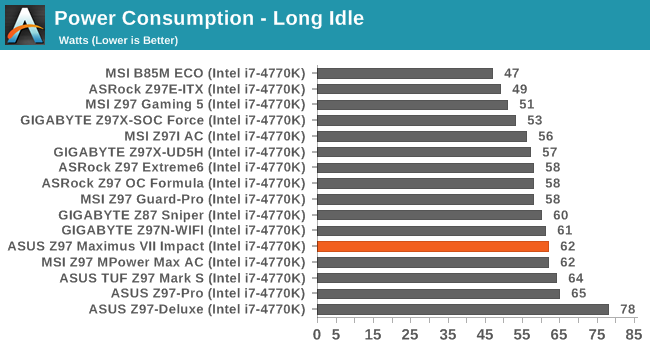
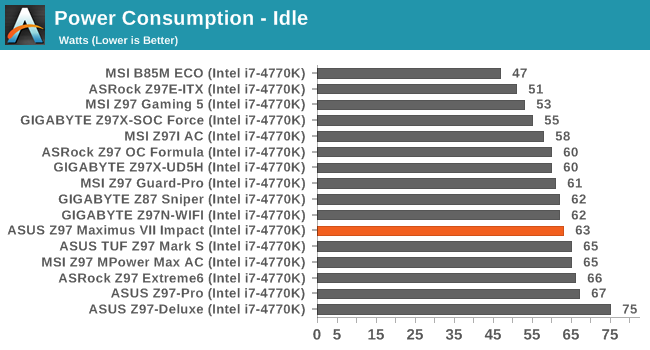
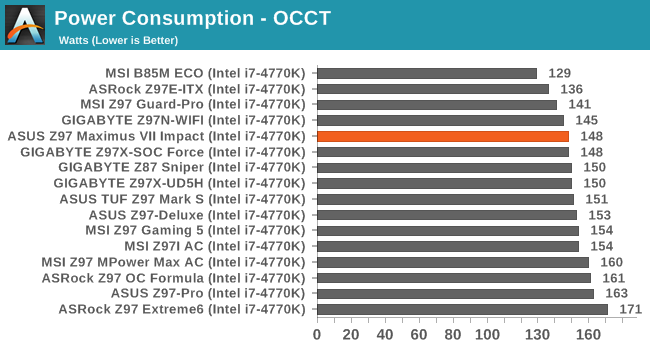
Peak power consumption was just under the 150W mark, resulting in a low idle-to-peak variation of 86W. Idle numbers were actually quite high, though it is hard to pin down if this is down to general design choices or the daughterboard design resulting in small but extra losses.
Windows 7 POST Time
Different motherboards have different POST sequences before an operating system is initialized. A lot of this is dependent on the board itself, and POST boot time is determined by the controllers on board (and the sequence of how those extras are organized). As part of our testing, we look at the POST Boot Time using a stopwatch. This is the time from pressing the ON button on the computer to when Windows 7 starts loading. (We discount Windows loading as it is highly variable given Windows specific features.)
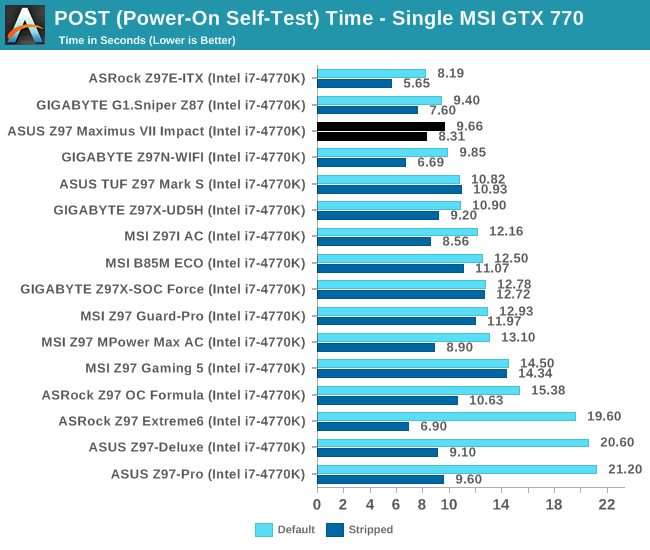
Less than 10 seconds POST time is a good benchmark in which the Impact did well.
Rightmark Audio Analyzer 6.2.5
Rightmark:AA indicates how well the sound system is built and isolated from electrical interference (either internally or externally). For this test we connect the Line Out to the Line In using a short six inch 3.5mm to 3.5mm high-quality jack, turn the OS speaker volume to 100%, and run the Rightmark default test suite at 192 kHz, 24-bit. The OS is tuned to 192 kHz/24-bit input and output, and the Line-In volume is adjusted until we have the best RMAA value in the mini-pretest. We look specifically at the Dynamic Range of the audio codec used on board, as well as the Total Harmonic Distortion + Noise.
Unfortunately our audio results were a little off due to a defect in our sound system. As shown in the image above, we had an odd situation where less than 300 Hz the THD+N response was some 30 dB different to what we would expect. ASUS sent us some results from a board in their offices that showed normal response, indicating that perhaps mine had a slight issue.
USB Backup
For this benchmark, we transfer a set size of files from the SSD to the USB drive using DiskBench, which monitors the time taken to transfer. The files transferred are a 1.52 GB set of 2867 files across 320 folders – 95% of these files are small typical website files, and the rest (90% of the size) are small 30 second HD videos. In an update to pre-Z87 testing, we also run MaxCPU to load up one of the threads during the test which improves general performance up to 15% by causing all the internal pathways to run at full speed.

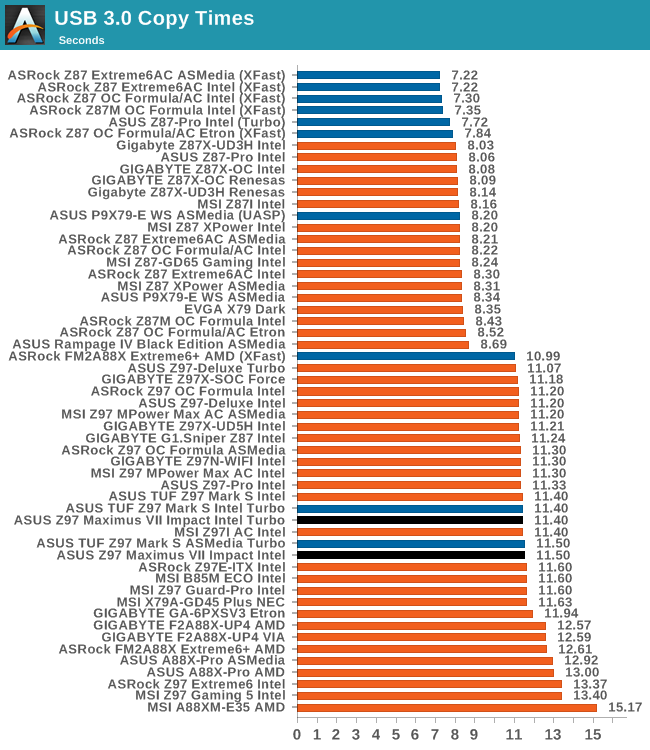
USB 2.0 performance on the Impact was slightly better than our previous Z97 results, with USB 3.0 coming in ballpark.
DPC Latency
Deferred Procedure Call latency is a way in which Windows handles interrupt servicing. In order to wait for a processor to acknowledge the request, the system will queue all interrupt requests by priority. Critical interrupts will be handled as soon as possible, whereas lesser priority requests such as audio will be further down the line. If the audio device requires data, it will have to wait until the request is processed before the buffer is filled.
If the device drivers of higher priority components in a system are poorly implemented, this can cause delays in request scheduling and process time. This can lead to an empty audio buffer and characteristic audible pauses, pops and clicks. The DPC latency checker measures how much time is taken processing DPCs from driver invocation. The lower the value will result in better audio transfer at smaller buffer sizes. Results are measured in microseconds.
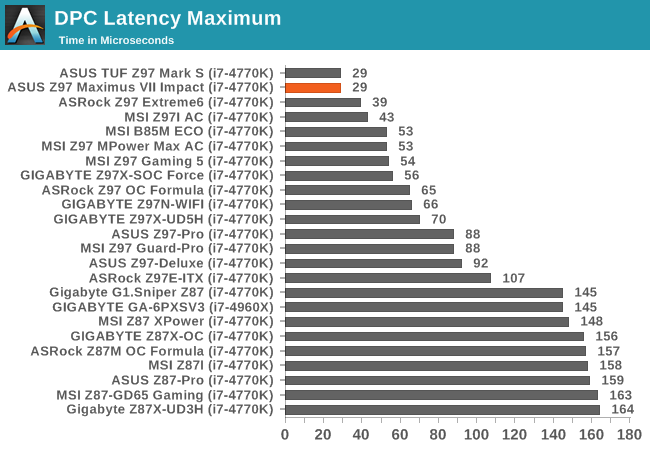
One of the super positive results to come from this review is the DPC Latency. The Impact came in at 29 microseconds, the same as the ASUS TUF Z97 Mark S, matching the best ever result.


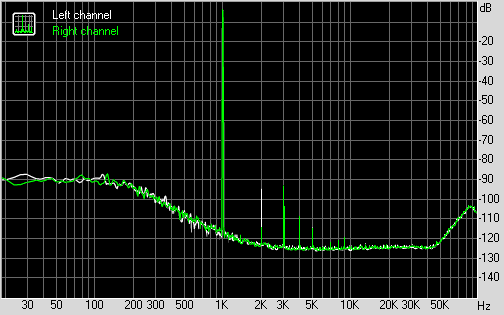








41 Comments
View All Comments
leetruski - Thursday, December 11, 2014 - link
Mind telling me where you found a bundle? I'm actually looking for one myself. Thanks.krazy_olie - Friday, December 12, 2014 - link
ah, it was an overclockers.co.uk bundle on Cyber Monday. I'm in UKmapesdhs - Thursday, December 11, 2014 - link
Interesting to compare to the Z97I-Plus, which is also a very good board. I built an HTPCwith this model, just a G3258 to begin with, 750 Ti, works very nicely indeed. It's also almost
$100 cheaper, money that could be spent on a better GPU, CPU, SSD, etc.
Ian.
krazy_olie - Thursday, December 11, 2014 - link
Most people would be better served by the plus but these types of boards are often in bundles so it was at no extra cost to me. The overclocking features are a bit overwhelming. I've just activated the 2133 xmp profile on my memory and left it as it is for now. From what I can tell is that by default if I do this it activates the "free" 4x4400Mhz boost. I may attempt to do some sort of undervolting at some point.Was able to try out the headphone output and was pleasantly surprised. Bizarrely plugging in to the rear it detects something, gives the option of headphones then sets to speakers but on the front panel it works. Not really an issue but weird, it detected my sennheiser hd598 as needing the middle amplification, >64 Ohm, setting but I switched it down to "performance" as it was loud enough for my tastes.
Subjectively it sounds better than my late fiio e17, excellent soundstage and separation. I can certainly hold off buying a replacement headphone amp for quite some time so I've made my money back there already.
Had a play with the sound add ons and they are potentially useful, but for general use best to turn it all off. The audio visualiser is a curious thing... arguably it's a form a cheating if you can see where the sounds are coming from! I suspect I will have fun trying to get it to play nice with games. 3d sounds is so awkward since direct 3d sound was deprecated
Just hoping that I will have more luck controlling the 3 pin fan with cha_fan1 vs the coolhub, otherwise I will need to resort to resistor cables or a new fan. Will report later on...
krazy_olie - Friday, December 12, 2014 - link
Chassis fan header 1 (CHA_FAN1) can control SC fans, seems like either an undocumented restriction on the coolhub or possibly a bug of sorts.Ronald Hummelink - Sunday, December 14, 2014 - link
I bought the same bundle from OCUK, and seems I can control both CHA1 and CHA2(Coolhub) fans fine. I just use custom fan profiles in BIOS, and both fans (and the cpu fan) follow CPU temperature fine.rakesh_hocrox - Friday, December 12, 2014 - link
Check out the latest tech news about Google here: http://bit.ly/1yGNZCWSuperVeloce - Friday, December 12, 2014 - link
Why are usb3 copy times that much slower on newer z97 chipsets?MajorDizaster - Saturday, March 14, 2015 - link
So, are you supposed to replace the screws on the CPU Power Daughter card heat sinks with longer screws to mount it to a case? Or do you only need to use the two free mounting holes?iLloydski - Monday, June 22, 2015 - link
i find it odd that nobody has talked about the fact that M.2 shares bandwidth with PCIe 3.0/2.0 X16 slot. Bandwidth on the PCIe 3.0/2.0 x16 slot becomes x8 when M.2 device is inserted.i'd like to know the impact of this with the graphics card if decide to use M.2 SSD. Thanks, appreciate the feedback.